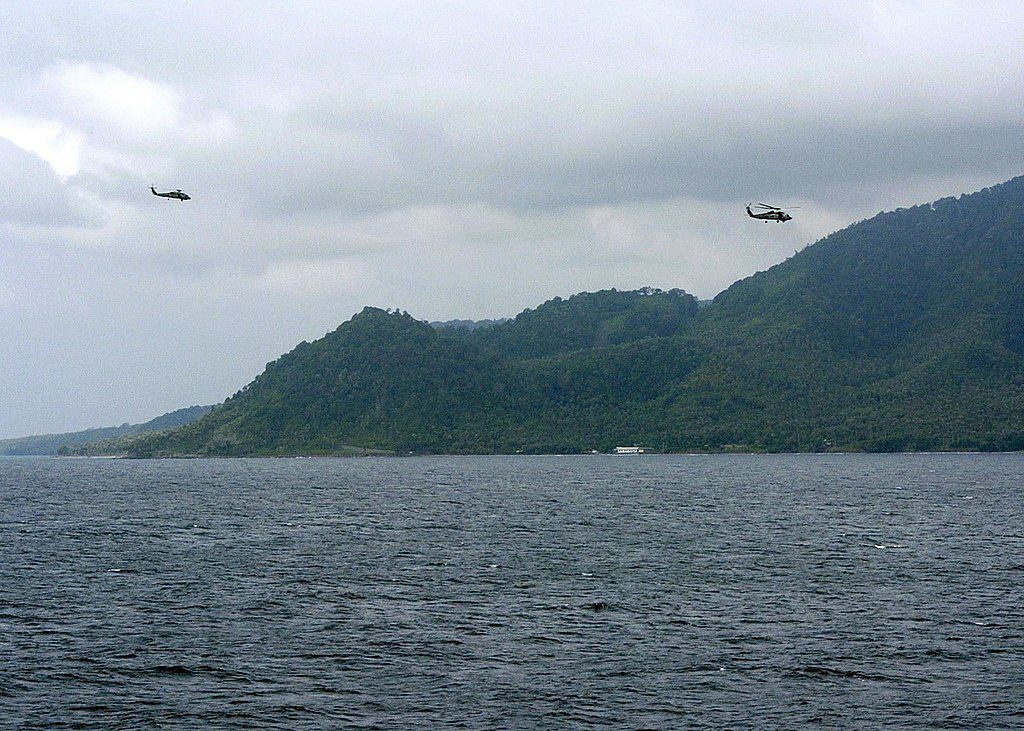15 Most Famous Historical Events that happened in Indonesia
*Originally published by Faith on July 2022 and Updated by Vanessa R on June 2023
The country is the fourth most populous country in the world. Indonesia has made advances over the years in terms of their economy and also politically. Therefore, this means that there are some events that have happened which impacted the country’s progress both negatively and positively. This article will look at 15 most famous events that have happened in Indonesia and their significance.
1 The second youth congress

A picture of the youth pledge from the second youth congress by Sania Amalia-Wikimedia
1928’s Second Youth Congress was the first public gathering where the concept of “Indonesia” and Indonesian nationality were introduced. This youth congress aimed at creating a country that was united by proclaiming one nation, one motherland and one language. The Indonesian national anthem, “Indonesia Raya,” was also performed.
The congress was held in three locations with the first one being at the Katholieke Jongelingenbond building, where hope for a united country was expressed. the second one was in the Oost Java Bioscoop building and the final one was at the Jalan Kramat Raya No, 106. The historical veracity of the “Youth Oath,” which is sometimes recorded as “Sumpah Pemuda” in Indonesian history books, is still up for question.
2 The proclamation of Independence
The Republic of Indonesia’s Independence Proclamation was made 71 years ago. A short remark was read out by Indonesian nationalist leader Sukarno on the morning of August 17th, 1945, in front of a small group of people assembled in front of his home at 56 Jalan Pegangsaan Timur in Jakarta.
Indonesia’s independence is hereby declared by the Indonesian people. The transfer of authority and all related matters will be handled diligently and as quickly as possible. August 17, 1945, in Jakarta. Soekarno – Hatta, in the name of the Indonesian people
The song “Indonesia Raya,” which is now the country’s anthem, was played while the red-and-white “Sang Merah Putih” flag was flown.
3. Round Table Conference of 1949

A picture of the Indonesian flag by Project Manhattan-Wikimedia
Sukamo who was the Indonesian nationalist leader declared the 1945 Indonesian Independence from Japan. This made the Dutch who had been expelled in 1942to view this as a chance to regain their colony. Therefore their attempt in going back to Indonesia developed and resulted in a full-scale war of independence.
After the Dutch occupational military came back, Indonesia engaged in both military and diplomatic conflict. Due to Indonesia’s success in suppressing a communist insurgency in 1948, it persuaded the UN, especially the US, to put pressure on the Dutch to attend a conference. As a result, the UN officially recognized Indonesia’s sovereignty.
4. The Communist coup in 1965
Without a doubt, this is one of the most contentious instances in Indonesian history. According to the official version of events, the Communist Party moved, kidnapped, and executed top army generals after becoming convinced that the army was planning a coup.
The succeeding events would cause a crisis in 1966, which would result in Sukarno’s ouster and the ascent of Suharto to the presidency. It is to be noted that this is what the official history claims, albeit there has still been much controversy on the conclusion of the “Old Order” under Sukarno and the start of the “New Order” under Suharto.
5. The presidential Decree of 1959

A picture of the presidential seal by Gunkarta-Wikimedia
This was made by the then president of Indonesia known as Sukarno who sought that the country goes back to the 1945 constitution because the constitutional assembly of the country failed to achieve the two-thirds majority required to form a national assembly.
This decision was suggested by the army chief of staff known as Abdul Harris who saw that the old constitution could be brought back to pave way for the military to run the state. The period lasted from 1959 to 1966 and it was known as the guided democracy.
Furthermore, the decree did well in the country even after the dissolution of the constituent assembly because it had the support of the military and thus allowing it to take effect.
6. The 1977 Election
To build and legitimize a system of government with President Suharto and the Indonesian military in charge, the New Order administration of that country held the first legislative elections since 1955 in 1971.
The government-sponsored Golkar organization received 63 per cent of the vote, 227 of the 251 directly elected seats in the DPR, and each of the nine indirectly elected seats in Western New Guinea as a result of government manipulation of the nine competing parties and military and government intervention. Additionally, Golkar received the remaining 100 seats in accordance with the 1969 Election Law, giving it 336 total seats, or nearly 75 per cent of the total.
While numerous political parties were represented in the prior election, President Suharto’s power began to grow after the 1977 election. Along with his own “Golongan Karya,” he combined several political organizations into just two: the socialist and Muslim parties (both under the PPP). As a result of Suharto’s support and the fact that Golongan Karya (Golkar) pretended to be a political party, it won every election after that until 1997.
7. The Crisis in 1988
Three factors can be said to have caused the economic meltdown in Indonesia and they include overreliance on foreign loans, adverse terms of trade and incompetent management. When the crisis happened, the government was incapacitated by the indecision to adopt a currency board and reduce state investments.
The crisis is one of Indonesia’s darkest periods. There was unrest in the capital. Daily robberies and rapes were in place. Growing animosity and discrimination against people of Chinese heritage were seen. Costs of living also soared. Occasionally, there are large-scale riots. Suharto would then make his departure announcement when demonstrators, primarily college students, surrounded the Parlament building.
8. The 1999 election

The campaign period in the 1999 elections by the Republic of Indonesia-Wikimedia
This was the first election after the New Order. 48 parties were present this time around, up from 3 in the previous election. The party led by Sukarno’s daughter Megawati, PDI-P, won the election, but Abdurrahman Wahid (Gus Dur) won the subsequent presidential vote held by the parliament.
9. The 2004 election
2004 was a pivotal year for Indonesia’s democracy. Several elections have been held, with the last round of the presidential election taking place on September 20.
On April 5, the first election was held to choose representatives for the province and county legislatures, the Council of Regional Representatives (DPD), and the Parliament (DPR). On that day, around 120 million voters cast approximately 600 million ballots.
Public opinion and the international community viewed the election as democratic, fair, and nonviolent. This also applied to the July 5 and September 20 first and second rounds of the presidential election.
10. The president’s visit to China
The president and first lady of Indonesia paid a state visit to China in an effort to improve ties between the two nations. This was the first official visit between the two nations since their diplomatic ties were restored. In 1991, Indonesian President Yang Shangkun paid a reciprocal visit to China.
11. Islam arrived in the 13th century
The introduction of Islam to Indonesia in the 13th century was a crucial turning point in the history of the country. The teachings of Islam were brought to the island by Islamic traders and academics from different places, which resulted in the development of Islamic Empires on all of the islands.
Islam increasingly became more common among the local populations, impacting local religious and cultural customs. As Islam became more widely practised, it changed laws, customs, and artistic expression while integrating in with regional traditions. Islam is now the national religion in Indonesia, determining the nation’s identity and fostering a wide and thriving Muslim community.
12. Asian-African Conference (1955)
A crucial moment in history took place during the Asian-African Conference in Bandung, Indonesia, in 1955. It brought together leaders from recently independent Asian and African nations to talk about shared difficulties and encourage solidarity. Racial discrimination, colonialism, and imperialism were among the topics that the conference planned to address.
The Bandung Conference became a defining moment for the newly established Non-Aligned Movement, which advocated for international human equality, national sovereignty, and the rule of law.
14. The Bali bombings that targetted tourists in 2002
Bali’s island and the entire world were shaken by the tragic Bali Bombings of 2002. A number of people were killed and injured as a result of the terrorist attacks that were directed at well-known tourist attractions. The incident had a major impact on both Bali’s tourism sector and the whole country. It also encouraged the Indonesian government to step up security measures and work with international allies to combat terrorism.
15. Indonesia was seriously affected by the Submarine Tragedy in 2021

U.S. Navy photo by Photographer’s Mate 3rd Class Tyler J. Clements, Public domain, via Wikimedia Commons
Indonesia was heavily affected by the Submarine Disaster of 2021. During a training operation in the Bali Sea, an Indonesian Navy submarine, the KRI Nanggala-402, disappeared. Despite intensive search and rescue operations, all of the crew members were sadly lost.
Planning a trip to Paris ? Get ready !
These are Amazon’s best-selling travel products that you may need for coming to Paris.
Bookstore
- The best travel book : Rick Steves – Paris 2023 – Learn more here
- Fodor’s Paris 2024 – Learn more here
Travel Gear
- Venture Pal Lightweight Backpack – Learn more here
- Samsonite Winfield 2 28″ Luggage – Learn more here
- Swig Savvy’s Stainless Steel Insulated Water Bottle – Learn more here
Check Amazon’s best-seller list for the most popular travel accessories. We sometimes read this list just to find out what new travel products people are buying.









